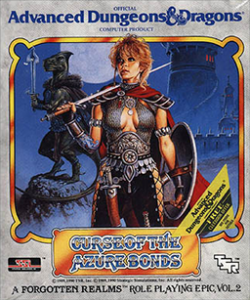The final area of Curse of the Azure Bonds does something singularly cruel: it locks you into a final 16×16 map sector until you either die or win the game, sending unlimited numbers of random encounters at you as you explore, while not letting you rest at all — the power of the sole remaining bond compels you to keep on moving. Since your supply of both spells and hit points is limited, it behooves you to find your way to the final chamber, where you confront the demon Tyranthraxus, as efficiently as possible. In other words, the solution is to explore thoroughly, mapping all the while, until you stagger half-dead into the final encounter, and then restore an earlier save and do it right this time. And while you’re at it, take a moment to trek back across the country to that one city that has a magic store and pick up some healing and speed potions for everybody. Speed potions are the key to killing powerful creatures quickly in this game, letting your warrior-types get in extra blows. Sure, the Haste spell does the same thing, and doesn’t cost you money, but money flows like water at this point (it got so I wasn’t even picking up platinum pieces any more), and it’s better to save your precious, unrenewable spell slots for something more directly deadly.
Really, though, the limited amount of spellcasting you can do in the endgame doesn’t matter as much as you might think, because by this point in the game you’ve doubtless picked up a bunch of wands and other spellcasting items, some (all?) of which can even be used by warrior-types. And if you’re at all like me, you’ve hoarded them without using them, so they’re all at full charge. Tyranthraxus has an army defending him, but what with one guy using a Wand of Fireballs, and another guy using a Necklace of Missiles (the missiles being fireballs), and another guy just plain casting Fireball, the defenders don’t last long. The fireballs don’t affect Tyranthraxus, though. He’s basically a fire god, but I don’t think that’s why; I think he just has a high magic resistance. D&D didn’t really do much with intrinsic elemental resistances at this stage in its history. Even the Efreets that I encountered earlier could be hurt by my fireballs, and they’re from the Elemental Plane of Fire, for crying out loud.
I don’t think I mentioned the name Tyranthraxus in my writeup of Pool of Radiance, but he’s the end boss there as well, albeit possessing a different body. And he retains some of the same habits, like letting strangers wander his territory unmolested by patrols as long as they mention his name when questioned. It’s different here, though, because until you get rid of the final bond, saying that Tyranthraxus is your master is actually the truth. Also, there’s good reason for those patrols to leave you alone: Tyranthraxus actually wants you to come to his lair, where his master plan would come to fruition, were it not for a last-second NPC-thrown monkey wrench. He turns out to be something of a puppet master in this game, manipulating you into ridding yourself of the first four bonds so that he can have exclusive control over you. That mysterious cloaked figure who I thought was probably Elminster? Not Elminster. Elminster doesn’t show up at all. Perhaps he was only mentioned in the manual to fool the player as I was fooled.
Anyway, that’s another Gold Box game down. By now I’ve pretty much gotten used to the user interface, including the peculiar key combinations required for diagonal movement on my laptop. (I did try an external keypad, but found it even more awkward than the combinations.) But also, the user interface is improved over Pool of Radiance in a number of ways that weren’t obvious at first. Remember how I said that what the game really needs in combat is something more like a rogue-like interface, where you can just move the current character without hitting a key to go into movement mode? CotAB supports something very close to that: there’s still a separate movement mode, but you automatically switch into it from the main action mode when you press a direction key. So, yay incremental improvements! Let’s hope they keep coming.
 Comments(0)
Comments(0)